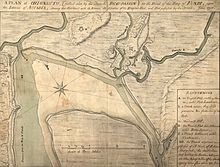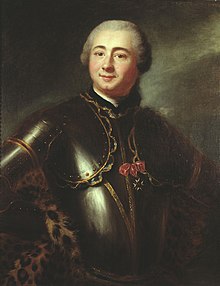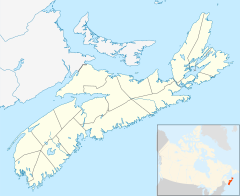Isthmus of Chignecto
The Isthmus of Chignecto is an
The isthmus separates the waters of
The name "Chignecto" derives from the Mi'kmaq name Siknikt, meaning "drainage place"; the name of the Mi'kmaq District where the isthmus is located.
Geography
The majority of the lands comprising the isthmus have low elevation above sea level; a large portion comprises the Tantramar Marshes, as well as tidal rivers, mud flats, inland freshwater marshes, coastal saltwater marshes, and mixed forest. Several prominent ridges rise above the surrounding low land and marshes along the Bay of Fundy shore, namely the Fort Lawrence Ridge (in Nova Scotia), the Aulac Ridge, the Sackville Ridge, and the Memramcook Ridge (in New Brunswick).
In contrast to the Bay of Fundy shoreline in the west, the Northumberland Strait shoreline in the east is largely forested, with serpentine tidal estuaries such as the Tidnish River penetrating inland. The narrowest point on the Northumberland shoreline is opposite the Cumberland Basin at Baie Verte. If sea levels were to rise by 12 metres (40 feet), the isthmus would be flooded, effectively making mainland Nova Scotia an island.[1]
Transportation
As the Isthmus of Chignecto was a key surface transportation route since the 17th century, French and later British colonists built military roads across it to the Tantramar Marshes and along the strategic ridges.
In 1872, the
In 1886 a railway line was built from Sackville across the isthmus to
In the mid-1880s, the isthmus was also the site of one of Canada's earliest mega-projects: construction of
In the 1950s, while construction of the St. Lawrence Seaway was underway, a group of industrialists and politicians from the Maritimes called for a Chignecto Canal to be built as a shortcut for ocean-going ships travelling between Saint John and U.S. ports to the Great Lakes to avoid travelling around Nova Scotia. The project, while endorsed by both the second Flemming government of New Brunswick and the Robichaud government that succeeded it, never progressed beyond the survey stage.
In the early 1960s, the
History
The first
Between the two ridges was a tidal stream called the
King William's War
- Raid on Chignecto (1696)
During King William's War, the first of the four French and Indian Wars, the English colonial militia leader Benjamin Church led a devastating raid on the Isthmus of Chignecto at Beaubassin, in retaliation for an earlier French and native raid against Pemaquid, Maine (present day Bristol, Maine) earlier that year.[3] Church and four hundred men (50 to 150 of whom were Indians, likely Iroquois) arrived offshore of Beaubassin on September 20. They managed to get ashore and surprise the Acadians. Many fled while one confronted Church with papers showing they had signed an oath of allegiance in 1690 to the English king.
Church was unconvinced. He burned a number of buildings, killed inhabitants, looted their household goods, and slaughtered their livestock. Governor Villebon reported that
the English stayed at Beaubassin nine whole days without drawing any supplies from their vessels, and even those settlers to whom they had shown a pretence of mercy were left with empty houses and barns and nothing else except the clothes on their backs.[3]
Queen Anne's War
- Raid on Chignecto (1704)
Major Church returned to Acadia during
On July 17, 1704 Church raided Chignecto. The Acadian settlers returned some gunfire but quickly sought shelter in the woods. Church burned 40 empty houses and killed more than 200 cattle and other livestock.[4]
On this campaign against Acadia, Church also raided
).The British took control of present-day mainland Nova Scotia under the
King George's War
During
Father Le Loutre's War
- Battle at Chignecto (1749)
During
- Battle at Chignecto (1750)
In May 1750, Lawrence was unsuccessful in getting a base at Chignecto because Le Loutre burned the village of Beaubassin, preventing Lawrence from using its supplies to establish a fort. (According to the historian Frank Patterson, the Acadians at Cobequid also burned their homes as they retreated from the British to
On September 3, Rous, Lawrence and
During these months, 35 Mi'kmaq and Acadians ambushed Ranger Captain Francis Bartelo, killing him and six of his men while taking seven others captive. The Mi'kmaq conducted ritual torture of the captives throughout the night, which had a chilling effect on the New Englanders.[6]: 159
- Raid on Chignecto (1751)
The British retaliated for the Raid on Dartmouth (1751) by sending several armed companies to Chignecto. They killed a few French defenders and breached the dikes, allowing the low lands to flood. Hundreds of acres of crops were ruined, which was disastrous for the Acadians and the French troops.[8] In the summer of 1752, Father Le Loutre went to Quebec and then on to France to raise funds and supplies to re-build the dikes. He returned in the spring of 1753.
In May 1753, Natives scalped two British soldiers at Fort Lawrence.[9]
Seven Years' War
- Battle of Fort Beauséjour (1755)

A British fleet of three warships and thirty-three transports, carrying 2,100 soldiers from
On the isthmus, the British abandoned Fort Lawrence and took over the better-constructed Fort Beauséjour, which they renamed Fort Cumberland. Shortly afterwards, the
- Skirmish at Chignecto (1755 July)
During the Seven Years' War, at Fort Moncton (formerly Fort Gaspareaux), one of Captain Silvaus Cobb's soldiers was shot from his horse and killed in an ambush. Cobb assembled 100 troops but was unable to catch the Mi’kmaq. Monckton dispatched 200 men from Fort Lawrence but was also unsuccessful in catching any Mi’kmaq.[6]: 179
- Raid on Chignecto (1755 September)

On September 15, Majors Jedidiah Preble[10] and Benjamin Coldthwait[11] took 400 men to destroy an Acadian village a short distance outside of Fort Monckton.[6]: 183
- Raid on Chignecto (1756 January)
On January 20, Boishébert sent François Boucher de Niverville to Baie Verte to burn a British schooner. Niverville killed seven soldiers and took one prisoner before burning the ship. Meanwhile, Boishébert and his 120 Acadians and Mi’kmaq tried to set up a siege of Fort Cumberland, but ended up escaping capture in a possible ambush.[6]: 186–187
- Raid on Chignecto (1756 April)
The Mi'kmaq and Acadians attacked Fort Cumberland on April 26, 1756. During the following two days, nine British soldiers were killed and scalped.[12]
- Raid on Chignecto (1756 October)
When Boishébert moved against Fort Monckton, the British abandoned it and burned it to the ground so that it could not be used by the French.[6]: 189
- Skirmish at Chignecto (1757 July)
On July 20, 1757, Mi’kmaq captured two of Gorham's rangers outside Fort Cumberland.[6]: 190
- Skirmish at Chignecto (1757 September)
On September 6, Monckton directed Lt. Colonel Hunt Walsh to take the 28th regiment and a company of rangers to Baie Verte to burn what was left of it. When they arrived, it was already vacated.[6]: 191
Yorkshire emigration
In 1758 Governor Lawrence issued a proclamation inviting New Englanders to come to Nova Scotia, settle on vacated Acadian lands, and take up free land grants. He also extended the invitation to New England soldiers serving in Canada whose enlistments had expired and who were planning on returning home. Such settlers became known as the New England Planters. Following the end of the Seven Years' War in 1763, the British created three 100,000-acre (400 km2) townships on the isthmus: Amherst, Sackville and Cumberland, which would later be dissolved into Cumberland County.
The drive to attract settlers from New England was not immediately successful. After a few small groups arrived in 1760 and 1761, some families returned home, and the British government decided to look elsewhere for settlers. Between 1772 and 1775, more than 20 ships arrived from England, carrying upwards of 1,000 settlers from
American Revolutionary War
- Battle of Fort Cumberland ("Eddy Rebellion")
In October and November 1776, local
The British burned eight of the rebel Acadians' houses and barns at Inverma Farm, Jolicoeur. With winter coming rapidly, the Acadians were forced to relocate with their families to Memramcook.[14] Eddy, Allan and many of the other English-speaking rebels were also expelled from Nova Scotia, but the American colonial government rewarded their efforts with land grants in Maine and Ohio.
References
- ^ "Sea level rise". Firetree.net. Retrieved 2022-08-26.
- ^ "Chignecto Ship Railway". Library of University of New Brunswick. Retrieved 2022-08-26.
- ^ JSTOR j.ctt15jjfrm.
- ^ "The Boston News-Letter". An historical digest of the provincial press. 1704-08-07. p. 112.
- ^ ISBN 0-86492-377-5.
- ^ ISBN 978-0-8061-3876-3.
- ^ Patterson, Frank H. (1917). A History of Tatamagouche, Nova Scotia. Royal Print & Litho. p. 19.
- ISBN 978-0-393-05135-3.
- ^ Murdoch, Beamish (1866). A History of Nova-Scotia, Or Acadie. Vol. II. Halifax: J. Barnes. p. 219.
- ^ "Genealogical sketch of the first three generations of Prebles in America : With an account of Abraham Preble the emigrant, their common ancestor, and of his grandson Brigadier General Jedediah Preble, and his descendants". Boston, Printed for family circulation, D. Clapp and Son. 1868.
- ^ Moody, Barry M. (1974). "Goldthwait, Benjamin". In Halpenny, Francess G (ed.). Dictionary of Canadian Biography. Vol. III (1741–1770) (online ed.). University of Toronto Press.
- ^ Linda G. Layton (2003). A Passion for Survival: The True Story of Marie Anne and Louis Payzant in Eighteenth-century Nova Scotia. Nimbus Publishing. p. 55.
- ^ Ernest Clarke (1995). The siege of Fort Cumberland, 1776. McGill Queen's University Press. pp. 215-.
- ^ Régis Brun (1982). De Grand Pré à Kouchibougouac. Éditions d'Acadie. pp. 59–60.
Bibliography
- Bernard Pothier, Battle for the Chignecto Forts, 1995, Toronto: Balimuir.
- Dr. John Clarence Webster, The Forts of Chignecto, 1930, self-published.
External links
- History of Chignecto, Central Library, Nova Scotia
- Peter Landry, "The Eddy Rebellion - Chignecto and the American Revolutionary War", in The Lion and the Lily, self-published, BluPete
- "The Chignecto Ship Railway - Engineer Henry Ketchum", University of New Brunswick Library Archives
- Chignecto-region - Acadian

